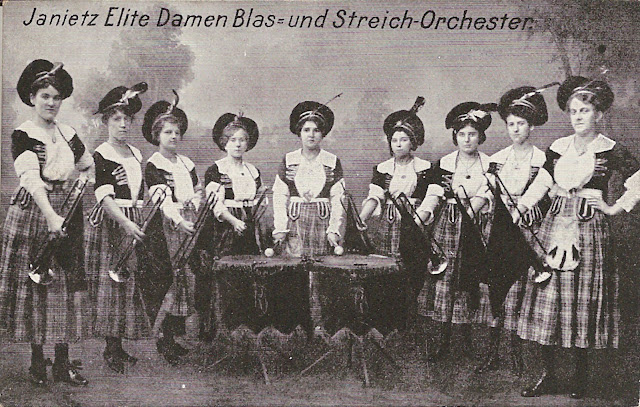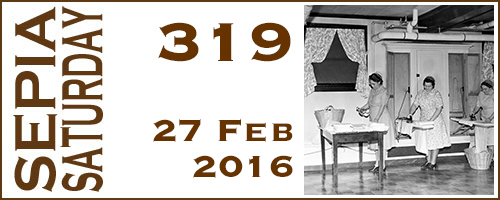Charming isn't the word for them.
Not graceful either. Definitely not lovely.
Fetching? No, that's not right.
Brazen comes to mind.
Formidable too.
How about imposing?
Let's settle for just Damen Blechbläser
Ladies of Brass.
Ladies of Brass.
They stand sternly at attention, these ladies of the Janietz Elite Damen Blas Orchester, awaiting a command to play a fanfare. Or two. These
Sometimes the Janietz Elite Damen wore plaid. Here the brass group has expanded to eight trumpets and one set of timpani. Each female musician of this German band is dressed in a Scottish style hat, complete with feather and a long plaid skirt, which is not exactly a kilt. At least one Damen has belted on a sporran, a masculine accessory not commonly seen on true Scottish lassies. These girls run to a more petite size than the previous two trumpet groups.
This postcard was printed in black and white, but Herr Janietz had other cards made in color. This next Janietz group has only five members but they wear the same Scottish costume.
Their hats and vests are in green velvet, while the plaid is, I believe, the Stewart tartan favored, or possibly even designed, by Queen Victoria. Today this seems a strange outfit for a German music hall band, but it should be remembered that the mother of Germany's Kaiser Wilhelm II, was Princess Victoria, the eldest child of Queen Victoria. And the British monarch's husband was Albert, who was a German prince of a Saxon duchy. Royalty often made strange bedfellows. Somewhere I expect there is a British counterpart to these postcards with an English ladies band dressed in Lederhosen.
But wait there's more.
The Fanfarenbläser of the Damen Trompeter Corps „Alpenveilchen“ are also ready to make a grand noise. You've also met these ladies before at the start this series of Ladies With Brass, that I first published in December 2013. Six young women hold natural trumpets in a traditional posture. They are dressed in identical costumes that are vaguely nautical since each girl wears a German sailor's cap emblazoned with the name of a German battleship. Each cap begins with the initials S.M.S., for His Majesty's Ship, followed by a name, each one different. The reason for this is because the Alpenveilchen Damen Orchester regularly performed in the North German seaports, as this postcard was sent from Bremen on 09 Sept 1909 to Herrn Georg Rodick of nearby Oldenburg.
The cap names are a bit clearer on this next postcard of the Fanfarenbläser of the Damen Trompeter Corps und Gesangs Ensemble „Alpenveilchen“. The addition of Gesangs meant they were also a vocal ensemble. Perhaps they sang German sea chanties in between trumpet fanfares.
 |
| European Alpenveilchen (Cyclamen purpurascens)Source: Wikimedia |
The name of this ladies band, and presumably the color of their dress, comes from the European Alpenveilchen (Cyclamen purpurascens) which is the German name for purple cyclamen, an alpine flower. The band's director was J. Reinstadler, who produced dozens of different postcards of his band. This group was slightly smaller than Herr Janietz's Elite Damen, with about 10 to 12 musicians. Almost all were women who played an assortment of brass instruments.
Sometimes they took the caps off, maybe at the request of the photographer, as this image shows six stalwart Alpenveilchen trumpeters in nearly the same dress with broad sashes, the collars being slightly different. This postcard dates from 09 September 1905, exactly four years earlier than the first J. Reinstadler group. It was sent from Aachen to Herrn Carl Miebach of Barmen near Düsseldorf.
Some ladies bands favored uniforms styled like those of military bandsmen. This next group of six brassy ladies are called the Oestrreich Damen Trompeter Corps „Bôhème“ from Austria. Their director's name was Albert Lohmann. Their caps are similar to the army capos of the Austrian-Hungarian army, but oversize to accommodate the women's hair. Their jackets also have swallowtail shoulder epaulets that were a special service mark of military band uniforms for many European nations. Their trumpets have flags with an embroidered design that looks like an emblem of a city or province, but in fact I think it is just a stylized musical lyre.
At the turn of the 19th century, the cafes, restaurants, beer halls, wine gardens, music halls, and city parks of central Europe offered entertainment by hundreds of these Ladies Orchestras. In German, the word Orchester was used for a musical ensemble that did not necessarily use string instruments. Most groups are shown with about 8 to 16 musicians, mostly women, and usually led by a man. Today we would call them a brass band with assortment of rotary valve brass instruments and percussion. The women wore elaborate costumes, all identical from the same dress maker, showing off the various ethnic and regional fashions that made up the vast empires of Germany and Austria.
The Damen Blas Orchester „Fortuna“, directed by Otto Noppe, shows another fanfare group with six trumpets and timpani. Their ornate dresses exhibit what is likely a very colorful folk pattern that nonetheless avoids any connection to risque theatrical costumes. This postcard comes with a postmark of 1905 from Düsseldorf.
These fanfare trumpets do not have valves, and are called natural trumpets because they are played exactly like bugles with a limited number of notes within a musical key. The length of the instrument determines the basic pitch and a group might use different size trumpets to add more notes for the ensemble. The instruments descend from the same design used for ancient herald trumpets, but during the Baroque era, brass instrument makers added small tone holes which were covered by the fingers of one hand. This allowed extra notes to fill in the musical scale. It is unclear if these German fanfare trumpets had that feature.
This image of six trumpeters from Max Lasch's Musik Specialitäten Ensemble show the instruments playing. There are four women and two men, and two of the longer trumpets have piston valves. The postmark is dated 24 January 1905 from Berlin.
The Fanfaren Quartett des I. Husaren Damen Trompeter Corps blare out a greeting from the Scheidnitzer Keller beer cellar in Dresden. Their Kapellmeister was August Gäde. They are dressed in German military band outfits. With the trumpets lifted to their lips, we can see that the flags have the royal eagle symbol of the German Reich. This postcard was sent from Dresden on 15 October 1904.
The four women trumpeters of the Fanfarenbläserinnen v. Damentrompeterkorps „Thuringia“ performed in a similar uniform as the Husaren corps. This postcard is unused but its sepia paper is similar to those from the war years of 1914 to 1918. Their impressive jackets include a shoulder board as well as the bandsman swallowtails. The trumpet flags are unfurled to reveal a fancy version of the German imperial eagle. The director was Arthur Schmidt from Clingen in the German Free State of Thuringia, hence the name.
If you've been keeping count, I've shown you 68 trumpeters and 5 timpanists. That is a very loud lot of brassy ladies. And these groups are just a small representative collection of a musical fad that characterized Germanic culture in the years before the end of the Great War in 1918. Ladies bands and orchestras were popular in other countries at this time, but female fanfare trumpeters were a distinctly German/Austrian phenomena. Because of the limitations of the natural trumpets, the music they played was militaristic fanfares and marching tunes. They did not use these instruments for jolly polkas or sentimental folk songs.
Fanfare trumpet ensembles are still found in modern Germany, but not anywhere as numerous. I've been unable to find any German female trumpeters, as the few contemporary groups I've found on YouTube are all male musicians dressed in Renaissance costumes for the tourists.
But I did find a very suitable video of an All-American group – the U.S. Army Old Guard Fife and Drum Corps Baroque Trumpet Ensemble. They are one of the President's White House ceremonial music ensembles, and here they perform a Cavalry Fanfare by the Bohemian composer, Jan Dismas Zelenka (1679-1745) for four trumpets. They are dressed in 18th century military uniforms with powdered wigs and use Baroque natural trumpets that have tone holes. However the two timpani are not authentic period instruments but are modern pedal machines.
I'm not certain, but I think one of the trumpeters is a woman.
Sadly femininity must be repressed for military uniformity.
Sadly femininity must be repressed for military uniformity.
***
***
This is my contribution to Sepia Saturday
where no one is ever bored with old photos.
where no one is ever bored with old photos.
















10 comments:
Formidable would be the right word for those ladies, amazing the bands, the costumes, the fashion; the imperial stance they take, drilled like soldiers.
I wonder if the Germanic popularity of this style of entertainment was brought to our US shores prior to the 2 world wars. That popularity would have died out as the anti-German sentiments took over of course. I am thinking of the many Germans who settled in Texas where my ancestors lived.
A fascinating collection of ladies' bands. I was really struck by the similarity of kettle drums and wash kettles when I saw the first couple of cards.
It’s rather a pity that they looked so stern, as in all other respects they are so fascinating; I’m sure they were told to affect this look. One or two seemed a little less forbidding than the others though.
"Perhaps they sang German sea chanties in between trumpet fanfares."..how funny! What a contrast that would be. I agree one of the
trumpeters in the ensemble looks like a woman. How in the world do people get these jobs in such little specific niches of the music world? Fascinating post.
What a wonderful wealth of pictures and information. A great & fun post as we've come to expect from you! Thanks for sharing. :)
Fun post. Would've sworn a jug band with the washboard and washtub bass were going to make an appearance this week.
A great collection of bands and their costumes. Yes they do look very formidable. I would not have fancied having to wash and iron those fancy white blouses and full skirts.
I'm beginning to wonder what music they played and what sort of concert they performed in. Some of the images make me think of vaudeville . Did they have performers in their beer halls ? Some sort of "popular" venue, not an upmarket venue, if you know what I mean
You are such a creative and talented blogger to arrive with these outstanding posts every week, and this week you have set the stage with the most lovely outfitted women of all time!
Post a Comment